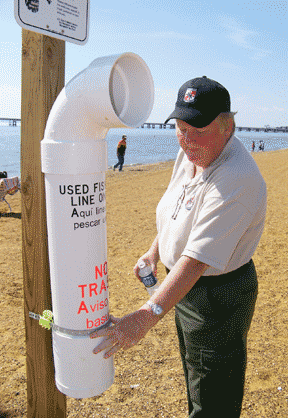 |
|||||||||||
|
|||||||||||
|
|||||||||||
Casting a Line for RecyclingAnglers learn new habits and turn old monofilament into new underwater habitatby Carrie Madren
Discarded fishing line is nasty. Like other plastics that endure in the Bay and the ocean, plastic monofilament doesn’t biodegrade. Once line falls into the water or tangles along the shoreline, it stays there. Worse still, rogue monofilament can kill. The strong line ensnares seabirds like gulls and osprey as well as fish and other wildlife. “It can prevent birds from feeding if they ingest it,” says Donna Morrow of the Department of Natural Resources, “or it can tangle beaks or feet. Fishing for LineTackle shops have long accepted used line for recycling. The catch is that an angler must futz with the tangled line, store it and remember to take it back to the store. But go to any fishing spot and you see that many don’t bother. To make it easier for fishermen to get rid of unwanted line — and to give new life to used monofilament — fishing line recycling programs are surfacing around the country wherever there’s water. Florida, one of the first states to promote widespread monofilament recycling, encourages parks and marinas around the country to do the same. The Sunshine State offers step-by-step instructions on its web page on how to build recycling tubes, how to print signs instructing anglers and how to get connected to line-recycling outfits. Maryland took the bait this spring. Maryland’s project was modeled on an identical one in Florida, says Donna Morrow, Maryland Department of Natural Resource’s coordinator for monofilament recycling. Funds for the DNR effort came from National Oceanic and Atmospheric Administration’s Marine Debris Grant Program, administered by U.S. Fish and Wildlife Foundation. Some $2,500 from the grant covered the cost of PVC piping, thread adapters and plugs — used to make the tubes — plus assembly and signs to notify anglers where to cast off old line. That bit of money bought 52 recycling tubes to post in 26 state parks, including Gunpowder Falls and Deep Creek Lake. Other parks and marinas including Sandy Point State Park and Point Lookout State Park bought and installed their own tubes. Each park, DNR reasoned, had both a convenient place to put the tube near fishing spots and headquarters to keep the cardboard shipping box safe and dry. Park staff at each site maintain the tubes, emptying each collection container every two to four weeks. Used line and spools are collected into a prepaid cardboard shipping box, then shipped to the company Pure Fishing, which recycles the monofilament through Berkley Conservation Institute. Closing the LoopIn Iowa, Berkley Conservation Institute “recycles the line into underwater fish habitats,” Morrow says. “If there’s a pond or lake without good cover, this gives small fish shelter to get a population started.” In the transformation from killer to habitat, the monofilament is melted down with plastic milk cartons and soda pop bottles and remolded into Lincoln Log-like structures, which can be stacked to create an artificial fish habitat where baitfish can retreat. The four-foot, non-degradable cubes can be bought with UPC codes off of Berkley Conservation Institute fishing tackle and other products. Send in enough codes — 75 UPCs — or $75 dollars, and they’ll ship you a habitat. Since 1990, the Iowa business has recycled more than nine million miles of fishing line. “It’s neat how it’s a closed loop kind of thing,” says Morrow, of fishing line reincarnated into fish-attracting habitat. Breaking the MoldOther parks and marinas have also spawned their own fishing line collections this year. Sandy Point State Park put up 10 tubes in March. Sandy Point’s maintenance supervisor, Bill Kramer, says materials — the same wide PVC pipes and signs — cost close to $2,000. The tubes bear messages in both English and Spanish, though the warnings about what discarded fishing line can do to fish, birds and other wildlife are only in English. The three-foot-tall, white, curved cylinders staked every 100 feet along Sandy Point’s fishing shore have, however, had only moderate success in collecting rogue fishing line. “I thought it would work,” Kramer says, but he still picks up plenty of monofilament buried in the sand with his beach cleaner, a pronged machine that rakes debris from Sandy Point’s sands. “We see birds tangled up in the trees all the time here,” he says. “I think that a lot of fisherman just don’t care or are too lazy. They just bury it in the sand.” Nancy Gardener, a seasonal park ranger at Sandy Point, thinks the problem is either language or lighting. Many anglers come in after dark. Some fishermen, however, seem to be catching on. “My wife and I were on vacation in Florida, on a tour, and they told us all about birds getting tangled up and dying,” said George Goodale of Sykesville, who baited hooks on two sand-anchored poles along the Sandy Point beach. “I recently found six or eight balls of fishing line — not mine — and tossed them in” to the recycling tubes. After a summer season of collecting line, however, Sandy Point didn’t collect the bonus of recycling. “There were maggots in the line [collection], and we ended up having to dispose of it,” said Mike Burditt, at Sandy Point. But he added, “the main idea is just to keep it off of the beach and out of the water.” Encourage your local fishing park or marina to post fishing line recycling boxes. Or make one for your own community: www.myfwc.com/mrrp/implementing.htm or www.purefishing.com. |
|||||||||||
|
|||||||||||
|
|
|||||||||||
|
© COPYRIGHT 2007 by New Bay Enterprises, Inc. All rights reserved. |
|||||||||||

